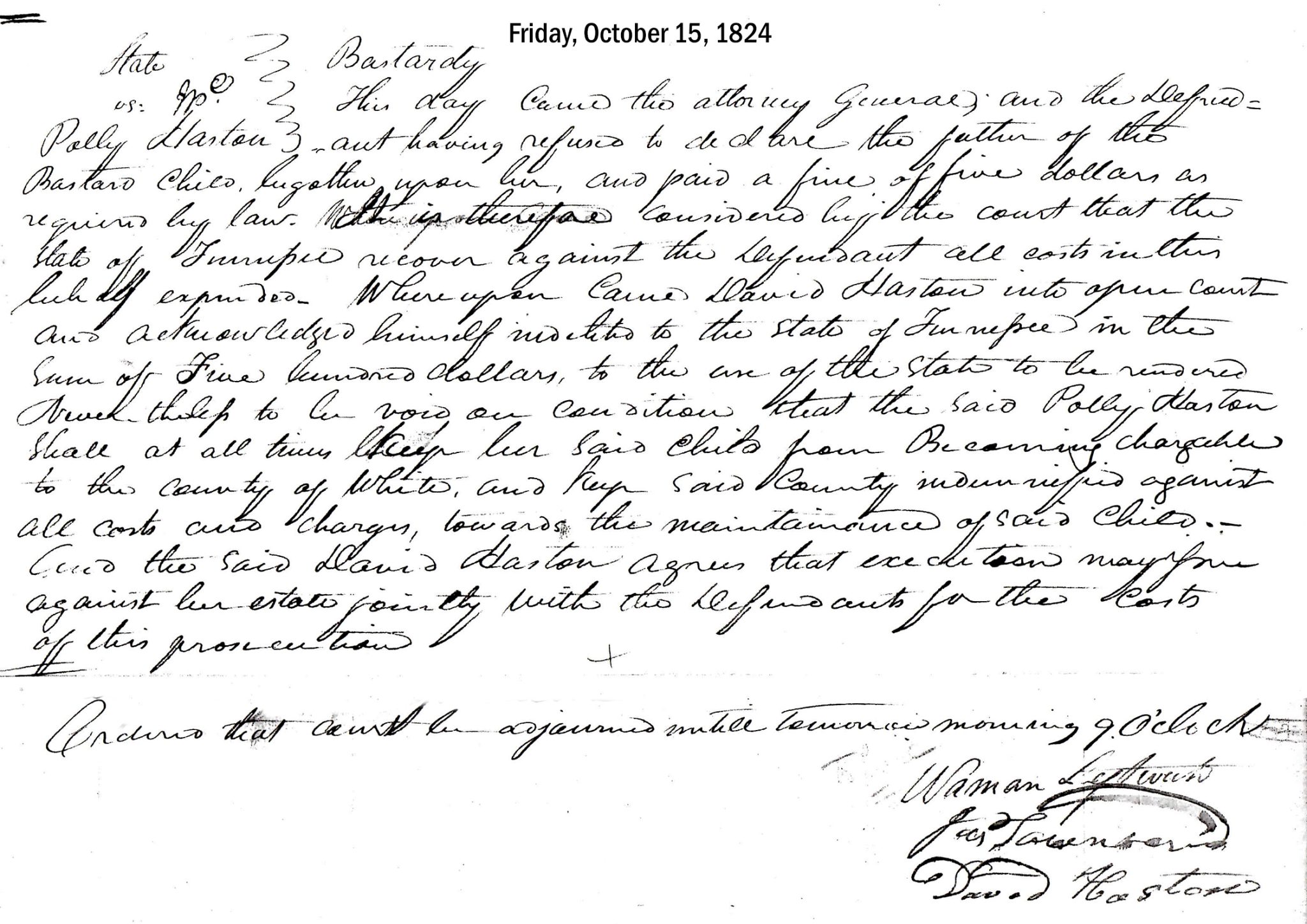37 - Mystery of the Mother of Montgomery Greenville Haston

As far as we can tell, the parents of Montgomery Greenville Haston–and how he fit into the Daniel Haston family–were unknown for well over 100 years! Even the most diligent Daniel Haston family researchers were stumped!
Montgomery Greenville [not Greenfield, as some have asserted] (M.G. or “Gum”) Haston lived a relatively short life even for his era, only about 45 (or 46) years. When he was about 15 ½ years old, Van Buren County, Tennessee was created. For a few years in the mid-1850s, M.G. moved his young family to Georgia to join members of his father-in-law’s family. But most of his adult life was spent in Van Buren County. But who was he? How did he fit into the Haston family?

Dave R. and Estelle Haston of Sparta, Tennessee spent several years researching the Haston family. They traveled many miles and wrote lots and lots of letters and compiled a very impressive summary of their research. The above quotation was taken from a July 12, 1984 letter that Estelle wrote to Margaret Banks, another family researcher of that era. Estelle’s admission, “We do not know where he (Montgomery Greenville Haston) came from or anything about him,” was the typical response for many, many years.
Unveiling the Mystery
August 16, 1824 (or 1823?) – As is true with many people born in the early 1800s or earlier, pinpointing the year of M.G. Haston’s birth is not without its challenges. It is very possible that M.G. himself was not certain of his birth year. M.G.’s present grave maker in the Big Fork Cemetery, which was probably erected much later than his burial, displays August 16, 1823, as his birth date. This date was probably based on his Bible record. But the 1850 and 1860 census dates suggest he was born in 1824, and there are other reasons to believe that he was born in 1824.
October 15, 1824 – On Friday, October 15, 1824, David Haston was performing his Justice of the Peace duties as a judge in the White County Quarterly Court. David’s 20-year-old* unmarried daughter, Mary (nickname “Polly”) Haston, came before the court and “refused to declare the father of the Bastard child begotten upon her and paid a fine of five dollars as required by law.”** Her father, David, “acknowledged himself indebted to the State of Tennessee in the sum of Five hundred dollars, to the use of the State to be rendered nevertheless to be void on condition that the said Polly Haston shall at all times keep her said child from becoming chargable [sic] to the County of White….”
*Mary (Polly) Haston was born January 22, 1804, according to the family records in David Haston’s Bible.
**From looking at several hundreds of bastardy bond cases in Tennessee and North Carolina records, it seems that (although it did occur occasionally) it was uncommon for the mother not to declare the name of the father.
There must have been some unusually serious reason why Polly refused to name the father. Was it someone who would have been extraordinarily embarrassed by her exposure of him? “Stay tuned” for the next article.

Bastardy Law
The earliest Tennessee laws regarding the births of illegitimate children (“bastards”) were based largely on North Carolina laws, which were based on English common law.
Under English common law, children born out of lawful wedlock were classed as bastards. In the eyes of the law they had no parents, no kindred, and no ancestors. They were not, then, entitled to a surname except such as they won for themselves by reputation, and they were heirs-in-law of no one. The great majority of them were apprenticed at a tender age to a master and condemned to a lowly existence.
Bastards ordinarily assumed the surnames of their birth mothers, but they otherwise suffered all of the common-law disabilities. Bastard children were thus disadvantaged from their birth. From as early as 1700, the mother of an illegitimate child could voluntarily appear before two justices of the peace and name the father of her child in a sworn statement, or she could be summoned by them and interrogated as to the father.[i]
The bastardy law under the first (pre-1834) Tennessee constitution stated:
Any two justices of the peace, upon their own knowledge, or information made to them, that any single woman within their county, is delivered of a child or children, may cause such woman, *after the expiration of thirty days from the time of her delivery, and not before, to be brought before them, and examine her upon oath concerning the father, and if she shall refuse to declare the father, she shall pay a fine of three dollars twelve and a half cents, and give sufficient security to keep such child or children from being chargeable to the county, or shall be committed to prison until she declare the same, or pay the fine aforesaid, and give security aforesaid.[ii]
*This must be by voluntary appearance and oath of the woman since, 1819.
[i] George Stevenson, “Bastardy,” NCpedia, accessed June 24, 2020, https://www.ncpedia.org/bastardy.
[ii] Haywood, Cobbs, Whiteside, and Chase, 22.
Was Mary/Polly Haston the Mother of Montgomery G. Haston?
The August 16 part of Montgomery G. Haston’s birth date is clearly established from his Bible record. It’s the year of birth that is in question. If he was born August 16, 1824, as census records appear to indicate, he was born almost exactly two months prior to Polly Haston appearing in court in the bastardy case (October 15, 1824). And the October session of the County Court would have been the next court session after the birth of Polly’s out-of-wedlock child.*
*As per an act of 1819, White County Quarterly Court terms began on the “second Monday in April and October and the third Monday in January and July.”[i]
[i] “Private Acts Compilations – White County, Tennessee (Administration – Historical Notes),” County Technical Assistance Service, accessed June 28, 2020, https://privateacts.ctas.tennessee.edu/content/administration-historical-notes-23.
This evidence alone should cause us to wonder—Was Polly Haston’s illegitimately born child Montgomery G. Haston?
But there are several pieces of additional evidence that appear to answer that question in the affirmative—Yes, M.G. Haston very probably was that illegitimate son of Polly Haston. For one thing, in the court records M.G. Haston frequently appears connected, in various ways, with David Haston or other members of the David Haston family. In every case, the Hastons with whom M.G. Haston was security bond-connected were from the David Haston family. (David Haston 2, David MC Haston 1, Thomas C. Haston 1, William Carroll Haston, 9).
Additional evidence emerges, piece by piece, throughout the chapter that is dedicated to Montgomery G. Haston in my forthcoming Daniel Haston family book.
And if Montgomery G. Haston wasn’t Polly’s illegitimate child, then we don’t know who the child was.
Next article: Who Was Montgomery G. Haston's Father?
If you appreciated this article, please share it with others who might also enjoy it.

